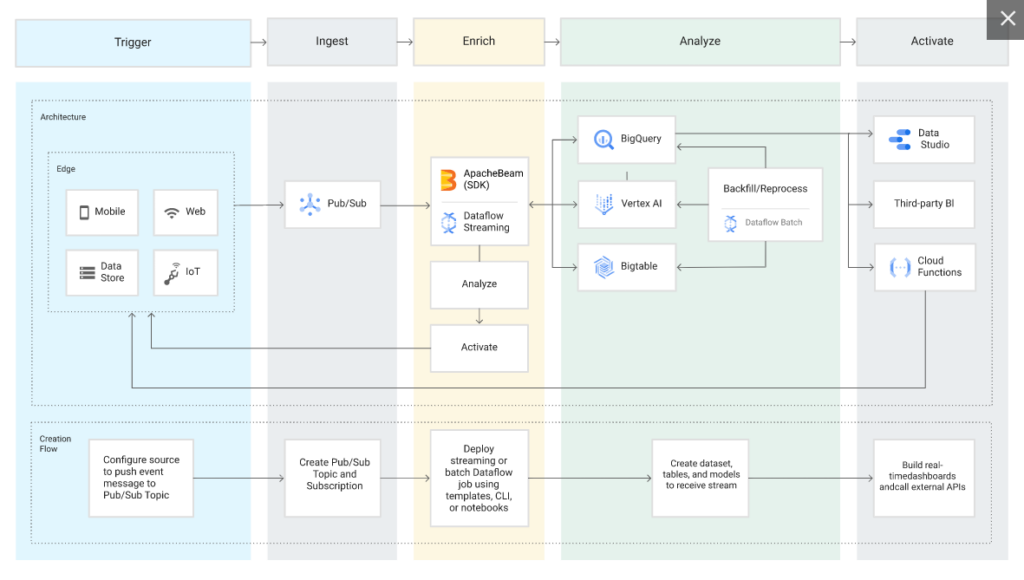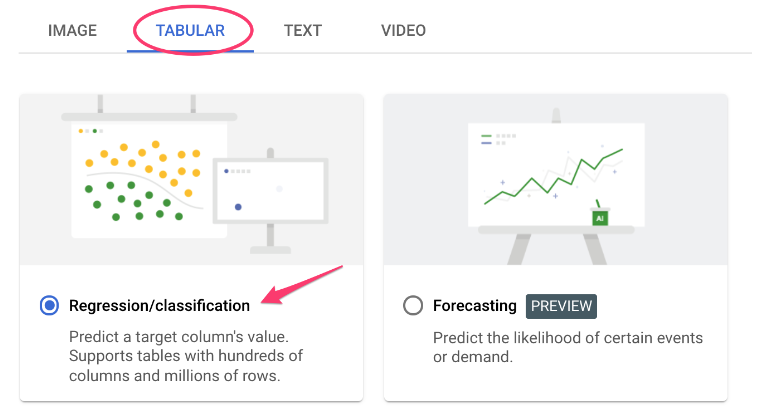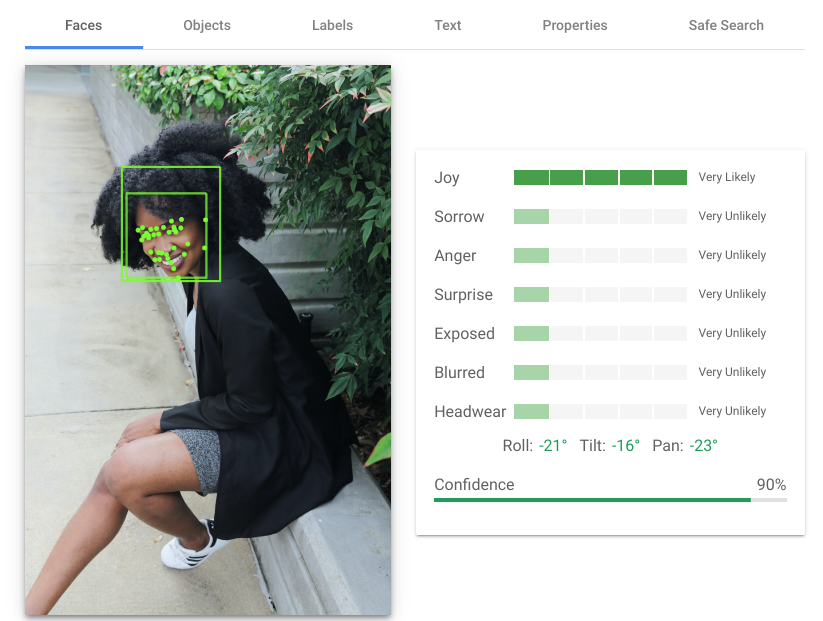Even though the sudden expansion of artificial intelligence seems to be a game changer, companies have been employing machine learning technologies for years. And as AI capabilities are expanding, so is the range of their applications in business. Below you will find the five most common business applications of AI services available on Google cloud.
Table of contents
What is AI?
The term Artificial intelligence refers to a range of machine learning models that computer science has created over recent decades. The acceleration in data science and deep learning models in the past few years has led to several major breakthroughs. Some of the most spectacular ones include Large Language Models (like OpenAI’s ChatGPT or Google’s Bard). Although these new tools are clearly impressive, AI-powered chatbots are merely part of a vast array of cloud AI services Google Cloud has to offer.
Machine learning models in the cloud
As Google cloud services have become more widespread and accessible, so have the AI platform solutions. Tools that took data scientists and engineers years to develop and refine are now available to anyone with a Google Cloud account. Instead of investing in costly deep learning model training, you can make us of a wide array of pre-trained models available on Google Cloud.
The most commonly applied tools include: BigQuery, Vertex AI, Vision AI and Speech-to-text. They are also some of the easiest to implement in your business.
What can cloud AI do for my business?
Every business that uses cloud solutions collects data, through transactions, websites, social media interactions, video footage and many more. If you want to focus your efforts where they can yield the most, you need to identify the areas of highest importance to your business and to do that you need to make the best use of your data possible.
We asked companies where they apply AI in their everyday business and here are the top 5 use cases for how to make the latest achievements in cloud computing work for your business. If you want to learn more about Google Cloud capabilities, ask our experts.
1. Customer insights and sales optimisation
Despite big data being talked about for years, many companies are still unaware of how much use they can get out of the large scale datasets they automatically collect from their transactions, social media and website traffic. While many data types can be useful, structured data, and tabular data in particular are crucial to making your AI models work for you.
Predict customer behaviour
BigQuery is the cheapest and easiest way to analyse customer behaviour and preferences, which offers actionable insights. It allows for a deep dive into understanding and predicting customer behaviour. A module called Matrix Factorization uses historical customer data, transactions and ratings to create the most effective product recommendation system and equipping your product teams with the tools they need to develop the optimal product mix.

Automate customer interactions
Speech-to-text can be applied to transcribe customer feedback from phone calls and chat conversations. Instead of consultants manually filling out rows and columns trying to the best of their ability to gauge customer sentiment based on how they interact with your staff or automated helpline, let cloud AI use an all powerful, objective tool to determine which areas need improvement. If your client base is international, AI-powered tools will provide a high-quality translation from one language to another.
Eye for detail
Vision AI can be used in a similar fashion to analyse customer images and videos to better understand their queries, choices and preferences, thus facilitating a business to create personalised experiences and ultimately improve customer satisfaction. Building and training neural networks for image classification can be time consuming and expensive, but with pre-trained machine learning tools, model training takes minutes instead of days.
Be like Spotify
One of the most well known uses of machine learning algorithms is Spotify recommendations based on your preferences. The use of collaborative filtering, wherein the algorithm collects each user’s historical data (their playlists and favourite artists, pieces they skip, the time when they listen etc.) and compares their music consumption with other, similar users to make the best recommendations.
Try out Google AI tools
If you would like to implement some of these solutions or if you just want to play around with AI models and features to get an idea of what might best serve your purposes and find out what other AI tools could make a difference for your business, ask our experts.
2. Quality control
A dissatisfied customer can do a lot of damage in the age of ubiquitous reviews, which makes quality control all the more vital for a business to grow and prosper. The second biggest use case for machine leaning tools available on Google cloud platform is quality control.
Find defective product
Vision AI can be a powerful ally in identifying defects and other quality issues. It doesn’t get bored or tired looking at the same products day in and day out and, when properly trained, it can be extremely accurate in detecting faulty items. It’s ability to detect objects and classify them on the fly can be a real asset when dealing with large volumes of items or quick turnaround. Another interesting example is using video footage from drones to inspect large structures and identify possible threats.
Machine learning models have long been proven to be more accurate in detecting anomalies, given sufficient data. Cloud AI models have already been pre-trained to learn from much smaller datasets, without the need to hire developers or big data scientists.
Analyse and predict
If you want an even more powerful solution for your quality control issues, plug in your data into BigQuery and it can tell you where and when the defects occur, while a predictive model built in Vertex AI can help you anticipate problems before they arise.
3. Supply chain optimisation
Supply chain issues have become a serious impediment to many businesses and entire industries. Optimising processes as much as possible has therefore become paramount for companies to run smoothly.
Avoid bottlenecks
Just like with sales, your supply chain data can be a source of invaluable information and actionable insights. BigQuery can be used to analyse data from suppliers and logistics providers, identify common problems and avoid bottlenecks. If you want to go one step further, you can use Vertex AI to develop predictive models to optimise your supply chain.
Optimise delivery
One of the best examples of how to optimise supply chain is the Travelling Salesperson Problem (TSP). It is a problem that has grown to be one of the main concerns of modern B2C businesses. The issue seems simple: how should a travelling salesperson, or a delivery vehicle, set out a route to cover all cities on the map only once. Additionally, we want them to have the shortest route possible. And end up in the same place they set out from.
Time vs computing power trade-off
It is basically the same problem every parcel delivery service solves every day, for every employee. And the solution of the TSP problem is rather simple. Or simply there is none. Mathematically, there is no way to find an absolute optimum, any solution is basically a trade off between time and computing power: the more computing resources you devote, the closer to optimising the route you will get. But at the same time, the closer you want to get to the best possible route, the more time you will spend calculating.
That is why most solutions to TSP optimisation aim at arriving at a “good enough” route, given the computing power available. Of course, having sufficient cloud computing power, like Compute Engine, resources become relatively cheaper and better solutions are within reach.
Google cloud platform tools over heuristics
The entire class of routing problems has long been tackled with AI, like Google OR-Tools (which stands for Operations Research Tools and contains a free and open-source software suite developed by Google for solving linear programming, mixed integer programming, constraint programming, vehicle routing, and related optimisation problems).
The overwhelming complexity of these problems may be too much for standard heuristic tools, but with the computing power of Google Cloud AI technology has been able to tackle the problem head on, arriving at solutions as close to optimal as possible. And given the scalability of cloud services, companies have been able to utilise the resources they need when they need them, without having to maintain costly infrastructure.

Expect demand spikes
A much simpler problem that many companies, especially cloud native ones, face is optimisation of cloud resources and making accurate prediction when they might expect a spike in activity. Some correlation is easy to predict, but many business owners found themselves taken aback by a sudden surge in traffic they could not explain easily. That is where BigQuery ML can be of great help. Let it churn your data and tell you what you’re missing, or where your next big opportunity lies.
4. Fraud detection
Despite being ubiquitous, fraud is also difficult to identify at first glance, which is why businesses invest heavily in fraud detection. The good news is that fraud detection is not a matter of installing state-of-the-art equipment or hiring extra personnel. The wealth of knowledge hidden in the data you already collect will enable you to focus on the areas that are the most vulnerable to fraud. Knowing where to direct your attention will allow you to both respond to and prevent fraud from taking place in your business.
Identify suspicious behaviour
Vision AI can be used to analyse surveillance video footage to identify suspicious behaviour. Meanwhile, speech-to-text can transcribe audio interactions with customers at a speed unrivalled by any human. They can then be analysed to detect fraudulent behaviour.
Sift through transaction data
Unsurprisingly, AI surpasses humans in analysing large volumes of information for many purposes, including fraud detection. BigQuery and Vertex AI can comb through your transaction data and raise flags, e.g. using AutoML tables.
All you need to do is prepare a dataset, e.g. in tabular form, which you can use to train AutoML to identify and label fraud. Then plug it into Vertex AI and start building your model to detect suspicious items. Here’s an official guide on how to set it up.

5. Sentiment analysis
The fifth most common use case of deep learning models in business is sentiment analysis. Why would that be of any use to your business, you might ask. The answer is simple: if your business deals with customers, it deals with emotional human beings. Rather than do guerilla-style damage control, it is always preferable to know what to expect and take action when necessary.
Automated helpline
The sheer volume of queries, complaints, returns and technical issues to solve is staggeering. So much so that human consultants are usually assigned to solve atypical problems, rather than repeat the same scenario. And that’s a great option, but you also need to know when a consultant should step in. After all, 81% of consumers say a positive customer service experience makes them more likely to return to a store with another purchase, according to a 2022 study by Zendesk.
More businesses than ever have already automated their initial customer contact. While there is still some hesitation on the part of customers, the truth of the matter is that time if of the essence and a speedy response from AI helpdesk can be far preferable to waiting for a human operator. Automation is simply the way to go, but there are also different ways of going about the transformation.
Anticipate negative feedback
Sentiment analysis can be used for images as well as for speech. You can use pre-trained AI models and train them to your specific needs. For instance, they can alert you when a customer exhibits signs of distress, frustration or annoyance. They can automatically connect the dissatisfied client with a human operator, with training to deal with this kind of situation.
AI-powered text analysis are getting better at analysing not only individual sentences but also the context words appear in. This enables social media specialists to quickly identify potential PR problems and respond to negative feedback. This way you can contain fallout before it becomes really damaging to the company’s image.

Try out google AI tools
Ask our experts:
- If you would like to implement some of these solutions,
- play around with AI models and features to get an idea of what might best serve your purposes,
- find out what other AI tools could make a difference for your business.
